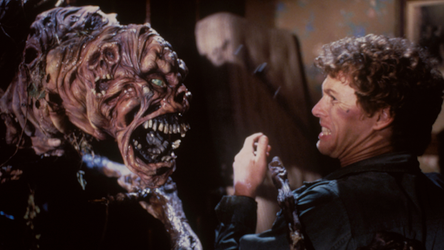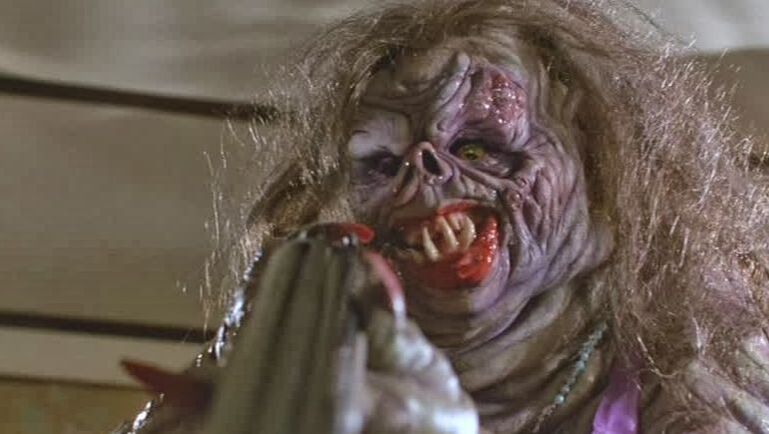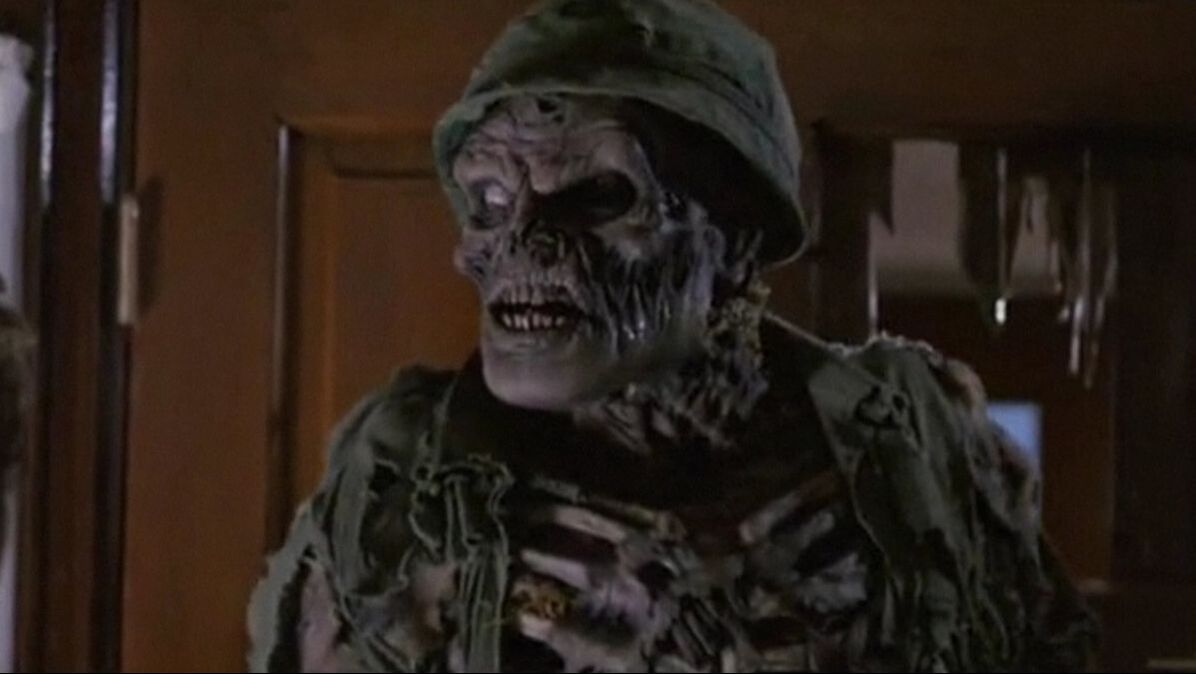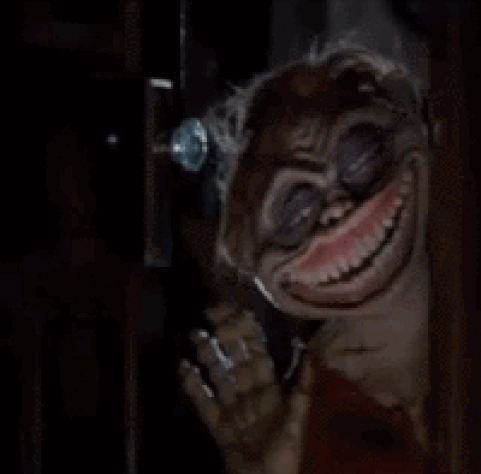 In this house, there be monsters… …Picture you’re walking along a quiet suburban street. Some houses have white, picket fences. Others have kids toys strewn about the lawn. One bold neighbor has even painted their house a neon pink. For the most part, they all look the same. But they’re not. Because inside those homes are individuals, with their own individual fears, guilt, and secrets buried beneath basements and tucked away in dark closets. Home is where the heart is, but it’s also where we hide the parts of ourselves we don’t want anyone to see, and sometimes, the person we’re most anxious to hide them from is ourselves. Director Steve Miner’s House (1986) brilliantly captures this concept, hiding the stark seriousness of the subject underneath goofy comedy and a plethora of fun monster makeup. Written by Ethan Wiley and based on a story by Fred Dekker (director of Monster Squad), House follows struggling writer Roger Cobb (William Katt), who has just learned that his Aunt Elizabeth (Susan French) has died, with her property left to him. Divorced, suffering from PTSD as a result of his time in Vietnam, and devastated over the disappearance of his son, Roger decides to get away from it all and spend time at his aunt’s house to write his book. Instead of peace and quiet though, he finds himself quite literally facing the skeletons in his closet, and a house that knows his greatest fears. “This house knows everything about you,” says a ghostly Elizabeth to Roger, and she’s right. The house does know everything about him, because the house isn’t a house at all. It’s a reflection of Roger’s own mind, and the walls he’s built around it to protect himself. Think about your own home. Look around you. You’re probably surrounded by things you enjoy. Movies, paintings, picture frames filled with family and friends. My house in particular is one big shrine to the horror genre. These are the things we keep on the outside, expressions of ourselves and the things we love. They’re what we allow others to see. But every one of us carries some kind of guilt that we hide, locked in places we don’t expose, and when we don’t talk about or admit that guilt, it festers inside of us. A ravenous monster feasting on our pain. And that’s where the creatures of House come in. Our first look at Roger’s own monsters in the closet comes when he encounters a literal monster in the closet. Measuring in around eighteen feet and needing fifteen people to operate it, the closet demon is made to look like napalmed bodies from Vietnam and sporting bullets for fingers. It’s an impossible to miss representation of the countless souls Roger took during the war. Sure, it’s on the nose, but that’s why it works. The closet demon is the concept of our skeletons in the closet yanked into a screeching, horrifying reality. Roger just has the misfortune of seeing his pain manifested before his eyes. Roger’s desperate attempt to snap a photo of the thing in his army gear is silly as Hell, but strikes at the heart of an honest truth that we’ve all faced: getting someone to recognize your pain is always easier said than done. Trauma, guilt, depression, none of them come with flashing neon lights screaming from our foreheads. They aren’t as obvious as physical cuts and scars. Getting someone, anyone, to acknowledge the seriousness of our mental suffering can feel like trying to get a photo of an elusive monster, and even if you get that crystal clear shot, it can still be damn near impossible to get anyone to believe you. Sometimes, I wish I did have a little ghoulie I could present to someone and say "See? Here's my pain. What do you think?" The greatest mistake anyone in House makes with Roger is in treating him like he doesn’t have his “act together”, as said by curious neighbor Harold (played by the always wonderful George Wendt). Roger isn’t insane. He’s miserable. And his monsters are very real, at least for him. Even his ex, Sandy (Kay Lenz), doesn’t seem to recognize the seriousness of Roger’s struggle. When Harold calls her to explain just how not together Roger’s act is, she shrugs it off and says she has to work. That’s the exact wrong thing to do. When I was a teenager, one of my friends called me, upset, and said they were done, then hung up. Nothing else, just “I’m done.” Up to that point, I had no reason to think anything was wrong. There wasn’t anything going on that I knew of, and they’d seemed fine when I last saw them. I could’ve just shrugged it off like Sandy and gone back to my business. Instead, I drove to their place in the middle of the night and pounded on their front door until their parents answered and let me in…right in the middle of my friend trying to end their life. He had his own monsters hiding within his walls, and I didn’t see them until it was almost too late. Some might look at this film and ask, well why didn’t Roger speak up sooner instead of letting these things fester? The short answer is that one of the hardest things we can ever do is to not only acknowledge guilt, but to forgive ourselves. Roger is failing, over and over again, to come to terms with losing his child and destroying his relationship over it. Both the bloated, hideous Sandy creature and the dual “critters” with their Joker grins are mocking reminders of that. “Your son is dead,” says the Sandy beast, cruelly giggling, and you have to imagine that’s something the real Sandy has said to him before, something he can’t bear to accept. Roger is so unwilling to deal with this, that he decapitates the Sandy thing and tries burying it in the yard, the way we attempt to bury the mental anguish we feel. I get it. If you opened up my head and took a look at the yard there, you'd probably see fresh patches of dirt everywhere. It’s no coincidence that it’s the Sandy creature’s severed hand grabbing at the feet of the hot thing next door, Tanya (Mary Stavin), and making Roger look like a psychotic weirdo. He can’t let his guilt over destroying his family go, regardless of how deep he buries it, and that grabby hand is an acknowledgement that thoughts of his son and Sandy are with him everywhere he goes. Throughout House, Roger is forced to open the closet door on every trauma, and reveal every ounce of guilt and shame hiding behind the peeling wallpaper of his mind. Miner employs consistent imagery of water and the color blue, implying that Roger is drowning underneath these feelings. Guilt and responsibility for our actions often feels like that; a nagging, horrible struggle to breathe, and the terrifying knowledge we may never reach the light of the surface again. Which is why this film is so much more powerful than it gets credit for, because it’s proof that no matter how deep the ocean of our guilt is, we can overcome it. Towards the end of House, we learn that Roger’s war buddy, Ben (Richard Moll) was wounded in battle. He begs Roger to kill him, but Roger can’t do it, abandoning him and leaving him to the Viet Cong and undoubtedly a slow, torturous death. It’s one moment, mere seconds, but it’s those seconds where we wish we would’ve done something different that haunt us, and it’s those seconds that have affected every aspect of Roger’s life. He thinks he’s a coward, and so instead of dealing with the reality of anything—his marriage, his missing son—he shrinks up, playing the part he has created for himself to a T. When Big Ben shows up in the end, a hulking, rotten soldier, he’s the embodiment of everything Roger fears: a metaphor for his cowardice. Ben calls him every name in the book, from a “coward” to a “wimp” and other schoolyard jabs, because that’s how Roger feels about himself. Guilt is a bully. And it’s the worst kind of bully, because it’s us bullying ourselves. Of all of Roger’s guilt, the souls he’s taken, the wife and son he’s let down, his pain over Ben is the most devastating, and the loudest. He’s that past trauma we can trace so much of our own issues to, that one thing that happened in our life that has changed us and set off a chain reaction of events that happen because we never learned to deal with it. Watching Roger finally turn his back on Ben, taking a page out of Nancy Thompson’s book and letting his deepest, darkest trauma know that he’s not afraid of it anymore…nothing beats that sort of catharsis. Nothing is as easy as that, but acknowledging the pain we have and choosing to forgive ourselves is a great first step, and why Roger is a hero to someone like myself who constantly faces my own demons. Whether you believe the events of House really happen or are just figments of Roger’s imagination, the lesson is the same: the more we try to keep our skeletons locked away in a closet, the more they fight to get out, and the more dangerous they become. Roger and his ghouls are stark reminders that we can never truly get rid of our own monsters until we open that closet door, take a deep breath, and face whatever is there in the dark. By Matt Konopka Please consider joining us in celebrating Women in Horror Month by donating to CineFemme at https://cinefemme.net/donate/
0 Comments
Leave a Reply. |
Archives
March 2023
|



 RSS Feed
RSS Feed